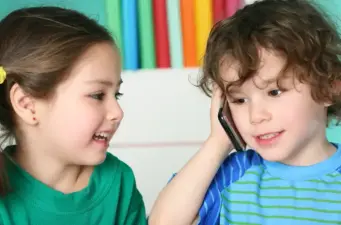
Are Adult-Child Oral Language Experiences Important for Early Reading Acquisition?
Learning Differences
Dyslexia
Written By: Susan Stanley
January 31, 2022
It is obvious that young children thrive on communications between themselves and the significant adults in their lives. Watch any family as they interact, and you will see the young child vying for attention of the adult, attempting to tell that person something they think is very important. Also, as you watch parents and children interact, look at the way a child gazes at that adult, drinking in every word that the adult is saying to the child. Yes, adult conversations are important to develop the phonological processors that lead to reading for a young child.

Being able to communicate effectively, using strong oral language skills, provides the foundation for learning in all academic areas. When a child has a well-developed knowledge of oral language and how it is used, the child is enabled to direct their own activities as learners. “In relation to early literacy practices, oral language skills provide the foundation of sound literacy development and are the prerequisite to written language” (Amorsen & Miller, 2017, p. 24).Because there is a reciprocal relationship between spoken and written language, these oral language skills will positively impact early and later achievements in learning to read (Morrow & Tracey, 2012).
In the year 2000, the National Reading Panel, through meta-research, determined that there were essential components of reading for a child to become a fluent reader with comprehension. The components included phonological processing, phonics, fluency, vocabulary, and comprehension. Continuing research has determined that the underpinning of oral language during the first five years of a child’s life will determine if a child becomes a fluent reader (Byrnes & Wasik, 2019; Clay, 2015a, 2015b; Fountas & Pinnell, 2016; Vukelich, Enz, Roskos, & Christie, 2020).
Oral language is defined as the knowledge and skills used to produce and comprehend spoken language, which are the foundation for learning to read and write. There are five important components of oral language:
- Phonology – using and understanding the speech sounds of words.
- Morphology – using and understanding the meaningful parts of words, such as prefixes and suffixes.
- Vocabulary or Semantics – using and understanding the meaning of words.
- Syntax – using and understanding the grammatical aspects of language.
- Pragmatics – using and understanding using language in a variety of contexts (Catts & Cordenas-Hagan, n.d.).
As a child has conversations with adults, these skills are further developed, providing the solid foundation for learning to read.

“Oral language is the foundation of learning to read and write. In the preschool years, development of oral language skills-including both speaking and listening skills-is crucial to children's future reading achievement and school success” (Anonymous, 2004). According to Chall (1983), developed oral language is highly predictive of learning to read and comprehension of text. Oral language comprehension is closely aligned with reading comprehension (Hoover & Googh, 1990). Konza (2011) purported that children who were included in “rich and increasingly complex conversations are highly advantaged in literacy development” (as cited in Downes, n.d.). When children are involved in oral language experiences with adults, they are able to develop extended knowledge about vocabulary, differentiate the variety of sounds of language, and begin to understand the structures of language. These children also build abilities to make meaning of their world, which is the basis for literacy. Oral language can be described as “the substrate for literacy” (Christensen et al., 2014, p. 18), with the number and variety of words heard building a vocabulary with has an impact on their future reading acquisition (Fernald et al., 2006). When a young child has opportunities to use oral language in conversations with adults, hearing a variety of levels of vocabulary, their lexicon of words and vocabulary is exponentially expanded.
As research has shown, the most important way for a young child to develop their own oral language is to have conversations with the adults in their lives. The goal, though, is for the adult to talk with the child, not just to a child. When a child is spoken to, this requires the child to listen, labeled as “receptive language”. Listening is a passive action where the brain does not activate any activity prior to receiving an incoming message. Oral language, when spoken with a child, is active, requiring the child to develop a mental picture and then communicate the response orally. This is known as “expressive language”. When adults speak with a child, instead of just to the child, expressive language is developed, allowing the child to “fine-tune” their comments with more precise vocabulary with each successive conversation (Reed & Lee, n.d.).

In 1998, the National Academy Press in Washington, DC published Preventing Reading Difficulties in Young Children, edited by Snow, Burns, and Griffin. In their seminal work, they identified “five broad areas of family functioning that may influence reading development” (p. 121). They were:
- Value place on literacy: by reading themselves and encouraging children to read, parents can demonstrate that they value reading.
- Press for achievement: by expressing their expectations for achievement by their children, providing reading instruction, and responding to the children’s reading initiations and interest, parents can create a press for achievement.
- Availability and instrumental use of reading materials: literacy experience are more likely to occur in home that contain children’s books and other reading and writing materials.
- Reading with children: parents can read to preschoolers at bedtime or other times and can listen to schoolchildren’s oral reading, providing assistance as needed.
Snow et al. went on to discuss the importance of verbal interaction in the family. When there is little to no verbal conversations in the family, the young child can be at risk for delayed reading acquisition. These effects may not show until after the primary grades when higher-level comprehension is required. Two important aspects of children’s oral language experiences are that they happen in the “context of meaningful social interactions with family member, and that it is interdisciplinary in nature” (Callahan & Braswell, n.d.).
When children arrive at school for the first time, they need to have a vocabulary of 4000-5000 words, orally control most grammatical structures, speak orally for many purposes, and adjust their talking according to the context (Amorsen & Miller, 2017).“Decade after decade of research shows that the amount of time a child spends listening to parents and other loved ones read is a good predictor of the level of reading attained later” (Wolf, 2007, p. 82).During the early years, children have been immersed in symbols in the “form of spoken words, pictures, signs, numbers, gestures, and writing…In order to read and understand even the simplest of texts, children must master a wide range of skills” (Callanan & Braswell, n.d.). For example, rhyming is the most efficient evidence of phonemic awareness. Children need to hear the sounds of rhyming words through nursery rhymes. According to Birsh and Carreker (2018), the number of words children are hearing is important, but more importantly “the differences in quality and the nature of conversation most affect language development” (p. 564). Cognitively challenging conversations between adult and child help develop a lexicon of words for a child to use in their own verbal interactions (Birsh & Carreker, 2018).
Playing with language is an important aspect of oral language experiences between parents and children. As cited in Birsh and Carreker, Moats and Paulson (2009) suggested using language strategies, purposely using language to describe what they are doing, describing what a child is doing, encouraging a child to use a variety of adjectives to describe objects in the room. While shopping in the grocery story, parents can ask questions about terms, such as hard, soft, rough, smooth, having the child feel and describe a variety of items in the store. The parent can use other items in the store to talk about the items and their uses. Using questioning, the parent can ask questions, such as, “What do we use paper towels for?” The game of “I Spy” is also a useful hook for extemporaneous language games parents can play with their pre-school child (Birsh & Carreker, 2018).
Brian Cambourne developed a list of eight goals for parents to use to enhance a child’s oral language and literacy development:
- Immerse or surround children in a playful and language-rich environment. Encourage them to develop a love of language.
- Model active listening, talking, reading, and writing activities for authentic purposes. For example, read a story that you really enjoy; make a shopping list together so you remember everything you need; check how to make your favorite meal, follow the instructions to assemble a new piece of furniture...
- Engage children actively in experimenting with language in a risk-free environment so they feel comfortable to make mistakes.
- Provide children with opportunities to succeed; have high expectations for their success.
- Give children responsibility to make choices about stories to tell and books to read. Set up the environment to enable easy access to books and promote self-direction.
- Accept children’s approximations when they are learning to talk (Play wego; we have ouch other; my lellow raincoat), read and write. Congratulate them on their accomplishments. Guide them gently into accuracy. In time they will self-correct.
- Create a climate for functional and meaningful uses of oral and written language. Encourage children to read along with you, help you write notes, letters, and lists, and engage in lots of conversations.
- Listen and respond to children, welcome their comments and questions, and extend their use of oral and written language. Celebrate their language and literacy learning! (as cited in Ewing, n.d., p. 5).
Early book reading has been supported for years by multiple studies, determining that this activity aids children in acquiring oral language and early print concepts. Children’s books, many times, have vivid, rich vocabulary, adding to a child’s lexicon of words. Reading aloud to children can build their knowledge of a variety of topics and content areas. Having books available for a young child is also beneficial for the child in acquiring literacy skills (Birsh & Carreker, 2018). Questioning during the reading of what happens next, why did she say that, who do you think did it, when do you think he found that, how could you do something like that, would you like to go there, where should he go next? Questioning is a simple, but impactful, strategy to impact oral language, as well as early comprehension skills.
Other strategies include involving children in conversations with adults, which positively impacts their receptive and expressive language skills. By helping a child expand their speech in a child-adult conversation, the child’s vocabulary and expressive language will be increased. Clay (2015s), as cited in Reed and Lee (n.d.), shared an example of this type of strategy:

Child: Ball
Adult: You need a ball? What kind of a ball do you need?
Child: Red
Adult: You want a red ball? How are you going to use the ball? What do you want to do?
Child: Play catch.
Adult: Oh. Are you going to play catch with Daddy?
Child: Daddy will play catch with me (p. 7).
Each adult response helps a child expand on what they are attempting to convey.
Reed and Lee (n.d.) also provided strategies for expanding children’s oral language, setting the stage for literacy acquisition. Dramatizing stories is a plan to help children use full body movement, along with props, to retell a story. The child’s language is about the character’s responses to the action instead of their own reaction. This activity allows children to be more involved in the activity, storyline, and characters, using oral language to comprehend the text.
Another strategy is the use of wordless books. These books provide a bound copy of pictures telling a story, with no words on the pages. Using wordless books provides an opportunity for a child to use his/her imagination to tell the story based on the pictures. This allows for the child to use expanded vocabulary and the parent to ask open ended questions for the child to further explain what is happening in the story. Wordless books can be used many times, as the child can develop a variety of stories based on the pictures (Reed & Lee, n.d.).

Toys are also an opportunity for oral language development. Many types of toys can effectively encourage a child to listen and speak. Pretend play toys help develop vocabulary skills in their social/emotional development. Pretending they are someone else, or playing with an invisible friend, by expressing social situations with that “friend” allows children to use a variety of words. Sensory play toys can help develop oral language by describing how the toy feels, smells, looks, tastes, and sounds. Examples of sensory toys are playdough, stacking blocks, balls of various sizes and textures. Children can use the toys, also, to expand their vocabulary by using prepositions, such as up, down, on, off, out, in (Reed & Lee, n.d.).
NILD Educational Therapy, as well as Search & Teach, are language-based interventions. Oral language is an important aspect of these interventions, as this treatise has supported. In every session, therapist-student talk supports each technique that is provided. The goal is for the student-talk to be primary, lending credence to how oral language impacts the young child in Search & Teach and the school age student with learning disabilities in NILD Educational Therapy.
As the NILD Level 1 presentation on Reading delineates, there are different stages of reading development. In the Prealphabetic-Emergent stage, the child knows a few alphabet letters, generates rhymes, clap syllables, and can read his or her own name. In this stage, there is no strategy other than rote memory. This stage is necessary to build the platform for future language experiences. This stage usually happens when the child is ages 4 to 5, just before kindergarten. “Children who have phonemic awareness [phonological processing] skills are likely to have an easier time learning to read than children who have few or none of these skills”, a quote from the National Reading Panel in 2000 (cited in NILD Level 1 Instructor’s Guide, 2010). As the child is immersed in oral language experiences in their young lives, this stage will be solidly built, leading to future reading ability.
Using oral languages experience, beginning with the newborn, can support literacy acquisition as a child grows and matures in their language ability. Research has supported this seemingly simple strategy in a child’s life. “From the insights of Piaget, who observed and recorded study dialogue, to the understandings of Vygotsky and Feuerstein, who elaborated and refined his theories, it has become clear that students’ oral language helps direct their thinking processes. The fewer opportunities students have to verbalize and refine their thought, the less they can develop clear thought patterns allowing them to become independent, lifelong learners” (Hopkins, p. 83).

Susan Stanley, Ed.D., PCET, Literacy/Dyslexia Specialist
References
Amorson, A. & Miller, M. (2017). Children’s oral language development and early literacy practices. Educating Young Children: Learning and Teaching in the Early Childhood.
Anonymous. (2004). Oral language and early literacy in preschool: Talking, reading, and writing. Reading Today, 12(6).
Birsh, J. R. & Carreker, S. 2018. Multisensory teaching of basic language skills. Paul H. Brookes Publishing Co.
Byrnes, J. P., & Wasik, B. A. (2019). Language and literacy development; What educators need to know.
Callanan, M. A. & Braswell, G. (n.d.). Parent-Child conversation about science and literacy: Links between formal and informal learning. Learning in Places. Peter Long Publishing.
Catts, H. & Cordenas-Hagan, E. (n.d.). IDA Fact Sheet: Oral Language Impairments and Dyslexia.
Chall, J. (1983). Stages of reading development. New York, NY: McGraw-Hill.
Clay, M. M. (2015b). Change over time in children’s literacy development. Portsmouth, NH: Heinemann.
Christensen, D., Zubrick, S., Lawrence, D., Mitrou, F., & Taylor, C. (2014). Risk factors for low receptive vocabulary abilities in the preschool and early school in the longitudinal study of Australian children. PLoS ONE. Australian Journal of Teacher Education 9(7).
Downes, L. (n.d.). Sssh, be quiet! The importance of oral language use in school settings: Practical ways to use oral language to develop literacy skills. Practical Literacy: The Early n& Primary Years.
Ewing, R. (n.d.). The role of oral language in literacy development. Practical Literacy: The Early & Primary Years.
Fernald, A., Perfors, A., & Marchman, V. (2006). Picking up speed in understanding: Speech processing efficiency and vocabulary growth across the 2nd year. Developmental Psychology, 42(1), 98-116.
Fountas, I. C., & Pinnell, G. S. (2016). Guided reading: Responsive teaching across the grades (2nd ed.). Portsmouth, NH: Heinemann.
Hoover, W. A., & Gough, P. B. (1990). The simple view of reading. Reading and Writing, 2, 127–160. 10.1007/BF00401799
Hopkins, K. R. (2010). Teaching how to learn in a what-to-learn culture. Josey-Bass.
Konza, D. (2011). Understanding the reading process. Research into Practice, 1(1.0), 1-8.
Reed, J., & Lee, E. L. (n.d.). The importance of oral language development in young literacy learners: Children need to be seen and heard. Dimensions of Early childhood.
Snow, C. E., Burns, S, & Griffin, P.(1998). Preventing reading difficulties in young children. National Academy Press.
Tracey, D. H. & Morrow, L. M. Lenses on reading: An introduction to theories and models. Guilford Press, 2nd Ed.
Vulelich. C., Enz, B. J., Roskos, K. A., & Christie, J. (2020). Helping young children learn language and literacy: Birth through kindergarten. Hoboken, NJ: Pearson.
Wolf, N. (2007). Proust and the squid: The story and science of the reading brain. New York: Harper.